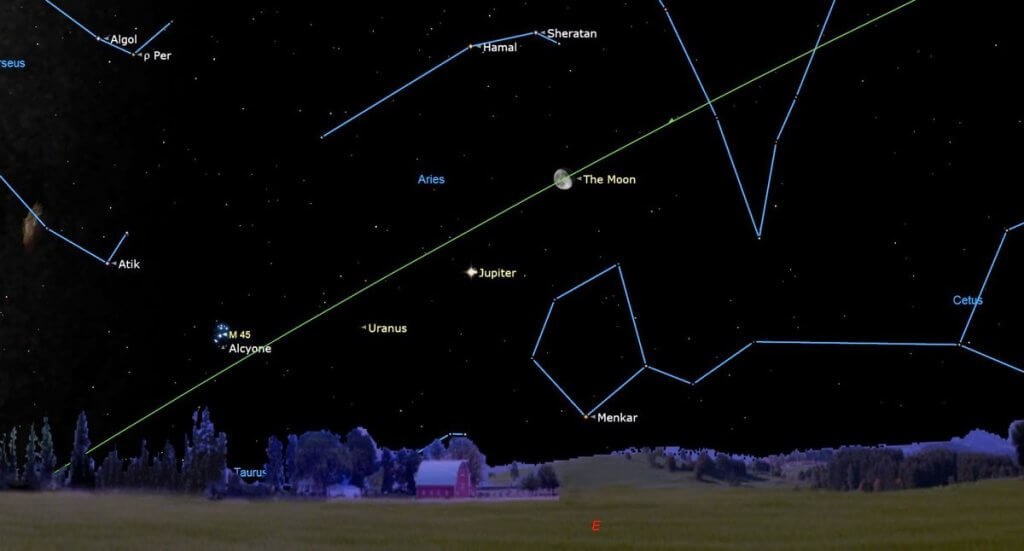
See the moon meet up with Jupiter in the night sky tonight (Image Credit: Space.com)
The moon will meet up with Jupiter tonight, making a close approach to the solar system’s largest planet in the night sky.
From New York City, the 19-day-old moon and Jupiter will be visible from shortly after they rise above the eastern horizon at around10 p.m. EDT (0200 GMT) until just before they dip below the horizon at around 11:52 a.m. EDT (1552 GMT) on Tuesday, Sept. 5, according to In the Sky. Jupiter will be just above and to the right of the moon.
Both the moon and Jupiter will be in the Aires constellation during the close approach and conjunction. The moon will be in its waning gibbous phase, with around 64% of the lunar disk illuminated by the sun during the close approach. Jupiter will appear within just 3 degrees of the moon, or about the width of two fingers at arm’s length.
Related: Night sky, September 2023: What you can see tonight [maps]

Want to see the moon or Jupiter up close? We recommend the Celestron Astro Fi 102 as the top pick in our best beginner’s telescope guide.
At around the same time as the close approach happens (also called an “appulse” ), the two celestial bodies will also join in an arrangement astronomers call a conjunction, meaning they share the celestial equivalent of longitude in the sky known as right ascension.
On Monday, the moon will have a magnitude of -12.3, while Jupiter will have a magnitude of -2.7 (lower and/or negative numbers indicate bright objects in the sky). Clearly, the moon will outshine Jupiter in the night sky and dominates it in terms of size by quite a large margin. This is a result of the fact the moon is much closer to Earth than the fifth planet from the sun, Jupiter.
In terms of actual size, the moon is much smaller than Jupiter is, meaning if the two celestial bodies were at equal distances from Earth, the gas giant would easily rule the night sky over our planet, dominating the moon.
Jupiter has a width of around 89,000 miles (143,000 km) making it 11 times the size of Earth. Our planet is itself around four times as large as the moon, which has a diameter of around 2,200 miles (3,500 kilometers). That means to stretch across the equator of Jupiter it would take at least 44 moons.
Jupiter is so vast that it has moons that are larger than not only our moon but even a solar system planet. The largest Jovian moon, Ganymede, is also the largest moon in the solar system with a diameter of 3,270 miles (5,268 km). That makes it wider than the planet Mercury, which has a diameter 3,032 miles (4,879 km), around a third the size of Earth. Jupiter’s moon Titan is also larger than Mercury, but this is because of its puffed-out atmosphere.
Despite the moon and Jupiter sharing a close approach tonight, the two will still be too widely separated to be seen together in the narrow field of view of a telescope. The moon and Jupiter should be visible together with binoculars, which have a wider field of view, however.
If you are hoping to catch a look at the moon in conjunction with Jupiter, our guide to best binoculars are a great place to start to help you find some wide-angle optics that are easy to transport. But if you want to look at either one up close, check out our guides to the best telescopes or the best budget telescopes.
And you’re looking to snap photos of these celestial objects or the night sky in general, check out our guide on how to photograph the moon, how to photograph planets, as well as our best cameras for astrophotography and best lenses for astrophotography.
Editor’s Note: If you snap an image of the moon with Jupiter and would like to share it with Space.com’s readers, send your photo(s), comments, and your name and location to spacephotos@space.com.





